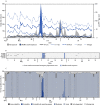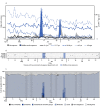Asthma-Associated Emergency Department Visits During the Canadian Wildfire Smoke Episodes - United States, April- August 2023
- PMID: 37616233
- PMCID: PMC10468220
- DOI: 10.15585/mmwr.mm7234a5
Asthma-Associated Emergency Department Visits During the Canadian Wildfire Smoke Episodes - United States, April- August 2023
Abstract
During April 30-August 4, 2023, smoke originating from wildfires in Canada affected most of the contiguous United States. CDC used National Syndromic Surveillance Program data to assess numbers and percentages of asthma-associated emergency department (ED) visits on days with wildfire smoke, compared with days without wildfire smoke. Wildfire smoke days were defined as days when concentrations of particulate matter (particles generally ≤2.5 μm in aerodynamic diameter) (PM2.5) triggered an Air Quality Index ≥101, corresponding to the air quality categorization, "Unhealthy for Sensitive Groups." Changes in asthma-associated ED visits were assessed across U.S. Department of Health and Human Services regions and by age. Overall, asthma-associated ED visits were 17% higher than expected during the 19 days with wildfire smoke that occurred during the study period; larger increases were observed in regions that experienced higher numbers of continuous wildfire smoke days and among persons aged 5-17 and 18-64 years. These results can help guide emergency response planning and public health communication strategies, especially in U.S. regions where wildfire smoke exposure was previously uncommon.
Conflict of interest statement
All authors have completed and submitted the International Committee of Medical Journal Editors form for disclosure of potential conflicts of interest. Jason D. Sacks reports support from the European Respiratory Society to travel to and participate in the meeting, Clean Air in Europe for All Air Pollution and Health: Taking Stock of the Proposed Revisions to the Ambient Air Quality Directive, in Brussels, Belgium in May 2023, and serving as vice chair of the Career Mentoring Committee, American College of Epidemiology. No other potential conflicts of interest were disclosed.
Figures



References
-
- Canadian Interagency Forest Fire Centre. Fire information. Winnipeg, Canada: Canadian Interagency Forest Fire Centre; 2023. https://www.ciffc.ca/
-
- Environmental Protection Agency. Integrated science assessment (ISA) for particulate matter (final report, Dec 2019). Washington, DC: Environmental Protection Agency; 2019. https://cfpub.epa.gov/ncea/risk/recordisplay.cfm?deid=347534 - PubMed
-
- Environmental Protection Agency. Technical assistance document for the reporting of daily air quality – the Air Quality Index (AQI). Washington, DC: Environmental Protection Agency; 2018. https://www.airnow.gov/sites/default/files/2020-05/aqi-technical-assista...
MeSH terms
Substances
LinkOut - more resources
Full Text Sources
Medical
Miscellaneous

